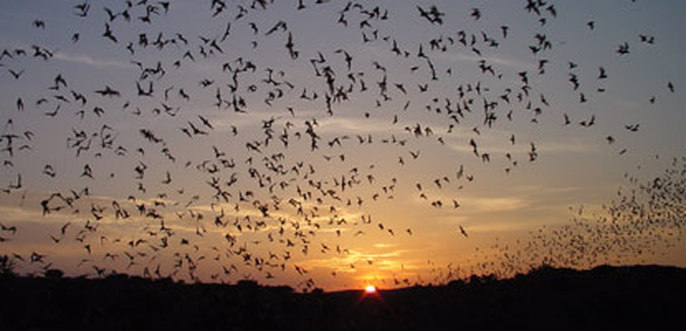Simplicity - The Bats
Simplicity
To remain humble in all efforts, still remaining purposeful, not shouting like a frog in springtime -the art of simplicity. Nature rewards directness and simplicity. Simple plants and animals that have adapted well within their niche thrive and add surprising color with their effort to remain colorless. The purposeful and useful bat is a wonderful example.

Bats
Non-bird aviators of dusk
Flying amongst the trees
Capturing snacks of varied kinds
Unfavored by humankind
Yet still sublime
Bats soar and dart from trees about dusk. Their Halloween reputation belies their usefulness in nature. Actually, many of the Native American tribes and even the Chinese may have valued the bat in a better manner than their European counterparts. The Northwest itself provides an inviting habitat for many varieties of bats, but most observers first spot The Little Brown Myotis. This bat has adapted so well to human infringement that the species thrives. Many no longer search for caves or large tree cavities for a nursery. Rather, this little mammal loves warm summertime attics. They choose these because their warmth assists incubation and their relative safety keeps the young free from natural predators such as snakes. Usually only the females will take up roosts while the males fly elsewhere to feed.
Bats are prolific foragers on small insects. They are rumored to be capable of eating the equivalent of 500 mosquitoes in an hour. They will gorge themselves within about 15 minutes and then rest to feed later, so the idea of them being a continuous eating factory remains myth. A lactating female needs even more and must compete with other females in the nursery area for the insects. Gregarious females group together in the “maternity” ward. Later, when the time comes in autumn to begin hibernation, they all will flock or “swarm” to a cave or mine, flying in or out for awhile, until they begin their long winter nap about October. Bats can live up to 30 years in the wild. Some are quite tiny, about the size of a moth. Some possess huge elephant size ears like the rare Port Townsend bat. Regardless of their sinister portrayal in much of folklore, their presence brings ecological balance in the woods.
“Join the great company of those who make the barren places of the earth fruitful with kindness. Carry a vision of heaven in your souls, and you shall make your home, your school and your world correspond to that vision.” Helen Keller
Non-bird aviators of dusk
Flying amongst the trees
Capturing snacks of varied kinds
Unfavored by humankind
Yet still sublime
Bats soar and dart from trees about dusk. Their Halloween reputation belies their usefulness in nature. Actually, many of the Native American tribes and even the Chinese may have valued the bat in a better manner than their European counterparts. The Northwest itself provides an inviting habitat for many varieties of bats, but most observers first spot The Little Brown Myotis. This bat has adapted so well to human infringement that the species thrives. Many no longer search for caves or large tree cavities for a nursery. Rather, this little mammal loves warm summertime attics. They choose these because their warmth assists incubation and their relative safety keeps the young free from natural predators such as snakes. Usually only the females will take up roosts while the males fly elsewhere to feed.
Bats are prolific foragers on small insects. They are rumored to be capable of eating the equivalent of 500 mosquitoes in an hour. They will gorge themselves within about 15 minutes and then rest to feed later, so the idea of them being a continuous eating factory remains myth. A lactating female needs even more and must compete with other females in the nursery area for the insects. Gregarious females group together in the “maternity” ward. Later, when the time comes in autumn to begin hibernation, they all will flock or “swarm” to a cave or mine, flying in or out for awhile, until they begin their long winter nap about October. Bats can live up to 30 years in the wild. Some are quite tiny, about the size of a moth. Some possess huge elephant size ears like the rare Port Townsend bat. Regardless of their sinister portrayal in much of folklore, their presence brings ecological balance in the woods.
“Join the great company of those who make the barren places of the earth fruitful with kindness. Carry a vision of heaven in your souls, and you shall make your home, your school and your world correspond to that vision.” Helen Keller
